What is Mother! about?
At its core, Mother! is a thought-provoking exploration of human nature, the environment, and the destructive tendencies of both. The film utilizes a unique allegorical approach to tell its story, where the characters and events are representative of broader themes. The biggest strength of the film is its ability to weave together biblical, ecological, and societal elements to create a compelling narrative that forces the audience to confront their own actions and beliefs. The chaotic and disturbing imagery serves as a stark reminder of the consequences of humanity’s selfish and destructive behavior, with the titular character’s suffering symbolizing the suffering of Mother Earth. By examining the relationship between creation and destruction, Mother! ultimately delivers a powerful message about the fragility of our world and the importance of preserving it for future generations.
Cast
- Jennifer Lawrence – Mother
- Javier Bardem – Him
- Ed Harris – Man
- Michelle Pfeiffer – Woman
- Brian Gleeson – Younger Brother
- Domhnall Gleeson – Oldest Son
- Jovan Adepo – Cupbearer
- Emily Hampshire – Fool
- Chris Gartin – Adulterer
- Stephen McHattie – Zealot
- Kristen Wiig – Herald
- Amanda Warren – Healer
- Laurence Leboeuf – Maiden
- Sarah-Jeanne Labrosse – Foremother
- Darren Aronofsky – Writer and director
The ending of Mother! explained
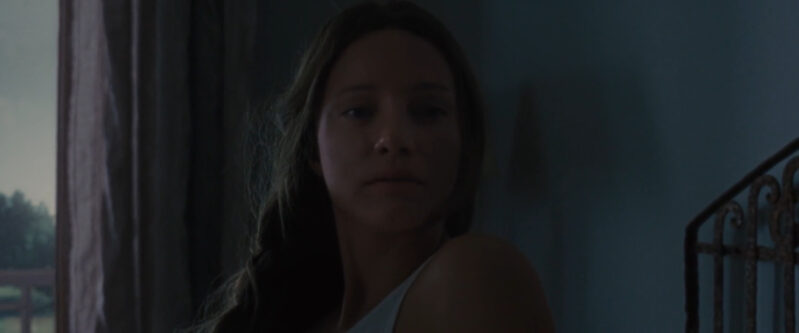
A recap of Mother!‘s ending
The chaos in the house intensifies as more and more followers of Him arrive, worshiping him and his newly written poem. They begin to take over every inch of the home, turning it into a war zone of sorts. Mother pleads with Him to make them leave, but he basks in the adoration, unwilling to turn them away.
Amid the pandemonium, Mother goes into labor, and she and Him take refuge in his study. After a painful and intense delivery, Mother gives birth to a baby boy. Him wants to show their son to his followers, but Mother refuses, fearing for the baby’s safety. She is distrustful of the crowd and their intentions. For a brief period, the couple remains in the study, with Him waiting patiently for Mother to fall asleep so he can take the baby to his followers.
Eventually, Mother succumbs to exhaustion and falls asleep. Him seizes the opportunity and takes their newborn son to present him to the worshipful crowd. When Mother wakes up and realizes what has happened, she desperately tries to retrieve her child. The baby is passed around the frenzied mob, and in a horrifying turn of events, they accidentally kill the infant, breaking his neck.
Overwhelmed by grief and rage, Mother watches in horror as the crowd mutilates and devours the baby’s body in a gruesome and sacrificial ritual. She violently lashes out at the crowd, but they turn on her, savagely beating and assaulting her. In the midst of this brutal attack, Him intervenes and rescues Mother from the mob. Her fury turns to the house itself, which has been destroyed by the chaos of the followers. In a final act of revenge, she locates a lighter and ignites the fuel-filled furnace in the basement, causing a massive explosion that engulfs the house in flames.
As the house burns, Him emerges unscathed, carrying a badly burned and near-death Mother in his arms. He explains to her that he is a creator who needs her love to fuel his creations, and that their home was a manifestation of that love. He then asks her for one more thing—her heart. Mother, resigned to her fate, grants his request, and Him reaches into her chest, pulling out her heart. Her lifeless body disintegrates into ashes, and as he crushes the heart in his hand, a crystal object emerges—the same crystal object that appeared at the beginning of the film.
The house, now in ruins, begins to regenerate as if rewinding time. A new day dawns, and the house is restored to its original state. A new woman wakes up in the same bed where Mother had once slept, and the cycle begins anew. The film concludes with the implication that this cycle of creation and destruction will continue, perpetuated by Him and his insatiable need for adoration and inspiration.
The religious allegories of Mother!‘s ending
Throughout the film, Aronofsky uses religious allegory to explore themes of creation, carnage, and human nature. The character of Mother represents the embodiment of Mother Earth, while the character of Him represents God or a divine creator. The arrival of Man and Woman in their home mirrors the biblical story of Adam and Eve, with the forbidden fruit taking the form of a crystal object that Him treasures.
As the film progresses, the allegory becomes increasingly explicit. The character of Him writes a book that becomes a religious scripture, and his followers soon flock to their home to worship Him as a divine figure. This worshipful adoration ultimately leads to the extermination of Mother and her home, reflecting the destructive nature of human ego and ambition.
In the final act of the film, Him’s followers become increasingly violent and fanatical, turning on each other and causing chaos. As Mother goes into labor, Him takes their newborn child and presents it to his followers, who proceed to mutilate and devour the baby in a sacrificial ritual. This sequence is a direct reference to the story of Jesus Christ, with the followers symbolizing the apostles and the baby representing the body and blood of Christ.
The ending of the film is the most explicit in its religious allegory. As the house is destroyed and Mother is consumed by flames, Him recreates the world in a burst of light and energy. The new world is populated by a new Mother, played by a different actress, symbolizing the cycle of creation and destruction that is inherent in religious mythology.
The environmental message of Mother!‘s ending
Alongside its religious allegory, Mother! also explores themes of environmentalism and human impact on the planet. The character of Mother represents the Earth, and the eradication of her home reflects the damage caused by human consumption and exploitation. The arrival of Man and Woman is a direct representation of human interference in the natural world, and their actions lead to the eventual collapse of the entire ecosystem.
Throughout the film, Mother’s efforts to preserve her home and maintain a sense of order are repeatedly thwarted by the calamitous actions of Man and Woman and all their friends. These actions include smoking in the house, breaking a sink, and even digging up the floorboards in search of the crystal object that represents the forbidden fruit.
In the final act of the film, the environmental allegory becomes even more explicit. As the chaos reaches its peak, Mother’s home begins to disintegrate, and the walls and floors become covered in blood and debris. This sequence is a direct commentary on the impact of human industry and consumption on the natural world, highlighting the destructive power of human greed and ambition.
The birth of a new mother
The ending of Mother! is a surreal and allegorical sequence that leaves many viewers confused and frustrated. As the house is destroyed and Mother is consumed by flames, Him creates a new world in a burst of light and energy. The new world is populated by a new Mother.
The ending can be interpreted in a number of ways, depending on one’s perspective. Some viewers see it as a message of hope, with the implication that even in the face of disaster, new life can emerge. Others see it as a bleak and nihilistic commentary on the repetitive nature of human folly and our inability to learn from our past mistakes.
One interpretation is that the ending suggests the inevitability of humanity’s ruinous cycle. Despite Mother’s efforts to maintain a sense of order and harmony, human nature and ambition ultimately lead to disorder and extinction. The new world created at the end of the film implies that this cycle is destined to repeat itself, with humans continuing to exploit and damage the Earth until its inevitable collapse.
Another interpretation is that the ending serves as a cautionary tale, urging viewers to recognize their responsibility in preserving the Earth and breaking the cycle of destruction. By presenting a vivid and horrifying portrait of environmental devastation, the film encourages audiences to take action in their own lives to prevent a similar fate from befalling our world.
The themes and meaning of Mother!
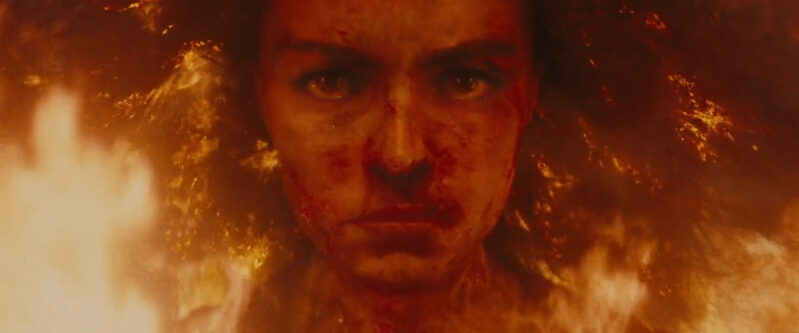
Humanity’s Relationship with the Divine
One of the most prominent themes in Mother! is its use of religious allegory, specifically drawing from biblical narratives to explore the dynamic between the characters and the world they inhabit. The characters themselves represent key figures from the Bible:
- Jennifer Lawrence’s character, Mother, symbolizes Mother Earth or Gaia.
- Javier Bardem’s character, Him, embodies God or the divine creator.
- Ed Harris and Michelle Pfeiffer’s characters, Man and Woman, represent Adam and Eve.
Throughout the film, Aronofsky uses these allegorical representations to construct a modern retelling of biblical stories, with a focus on creation, fall, and destruction. For instance, the arrival of Man and Woman at the house introduces the first disruption to the paradise that Mother and Him have created. This disruption is reminiscent of Adam and Eve’s arrival in the Garden of Eden. When Woman breaks the crystal object, an item that Him cherishes, it symbolizes the consumption of the forbidden fruit.
Another biblical reference occurs when Man and Woman’s sons arrive at the house, reenacting the story of Cain and Abel, with the elder son murdering the younger one. This event further disrupts the harmony of the household and marks the beginning of an escalating spiral of chaos and violence.
The climax of the film, where Mother gives birth to a baby boy, represents the birth of Jesus Christ. The subsequent mutilation and consumption of the baby by Him’s followers mirror the concept of Christ’s body and blood being consumed during the Eucharist.
The use of religious allegory in Mother! serves to explore deeper themes of creation, destruction, and humanity’s relationship with the divine. By grounding the narrative in familiar biblical stories, Aronofsky invites the audience to consider the broader implications of these allegories within the context of the film’s other themes.
Environmentalism and Humanity’s Impact on Earth
Another central theme in Mother! is environmentalism and humanity’s impact on the planet. Aronofsky has been fairly open about the allegorical nature of the film and its themes. In interviews, he has confirmed that the film is a retelling of biblical stories with an environmental message. Mother!, he says, is an allegory for the way humans treat the planet, with the destruction of the house symbolizing environmental devastation.
Jennifer Lawrence has elaborated on this thematic exploration as well, speaking about the intense emotional journey her character goes through and the film’s broader themes. She has mentioned that her character’s suffering represents the abuse of the Earth by humans and that the film serves as a call to action to protect our planet.
Early in the film, Mother’s role is to nurture and maintain the house, which serves as a metaphor for the planet. The arrival of Man and Woman, and later their sons, introduces a series of destructive events that gradually escalate. As more people arrive, Mother’s attempts to preserve and protect the house become increasingly futile. This dynamic symbolizes the way human activities disrupt the balance of the natural world and contribute to environmental degradation.
One particularly poignant scene occurs when Mother pleads with Him to make the growing crowd of people leave their home, exclaiming, “They’re ruining everything!” Him, however, is more interested in the adoration and validation he receives from his followers. This exchange underscores the film’s environmental message, highlighting the conflict between preserving the Earth and the human desire for power and recognition.
As the chaos reaches its peak, the destruction of the house becomes an allegory for the devastation of the planet. The final act of violence, where Mother ignites the house in flames, symbolizes the potential consequences of humanity’s continued exploitation of the Earth’s resources.
The Creative Process and the Artist’s Ego
Mother! also explores the theme of the creative process and the artist’s ego. Javier Bardem discussed how his character represents a creator figure and the dynamic between him and Mother. He has mentioned that the film explores the relationship between the creator and the creation, both in terms of the environment and in terms of artistic expression. Through the character of Him, a poet seeking inspiration, the film delves into the complexities of artistic creation, examining the relationship between the artist, their work, and their audience.
Throughout the movie, Him is portrayed as a creator figure, not only in the religious sense but also as an artist. He struggles with writer’s block until the arrival of Man and Woman, which sparks his creativity, leading him to write a poem that resonates with a wide audience. As more people become obsessed with his work, they flock to the house, worshiping Him and turning him into a cult-like figure.
The dynamic between Him and Mother illustrates the tension between the artist’s ego and their responsibilities towards their creations, as well as their personal relationships. Mother represents both the muse and the creation, providing Him with the love and support he needs to create, but also demanding his attention and care. As Him’s fame grows, he becomes increasingly absorbed in the adoration of his followers, neglecting Mother and their home.
A crucial line of dialogue that highlights this tension is when Him says to Mother, “I am I, and you are home.” This statement not only emphasizes their distinct roles but also reveals the extent to which Him views Mother as an extension of his creative environment, rather than as an equal partner.
The climax of the film, where Mother gives birth to a child, can also be interpreted as an allegory for the creative process. The baby represents the artist’s most vulnerable and personal creation, which is then exposed to the world and consumed by the audience. The horrifying scene of the baby’s mutilation and consumption by the frenzied crowd serves as a commentary on the destructive nature of fame and the vulnerability of the creative work in the public domain.
In the film’s conclusion, as the cycle begins anew with a new Mother, it is implied that the artist’s ego and the desire for adoration are inescapable driving forces in the creative process, leading to a continuous cycle of creation and destruction.
Why is the movie called Mother!?
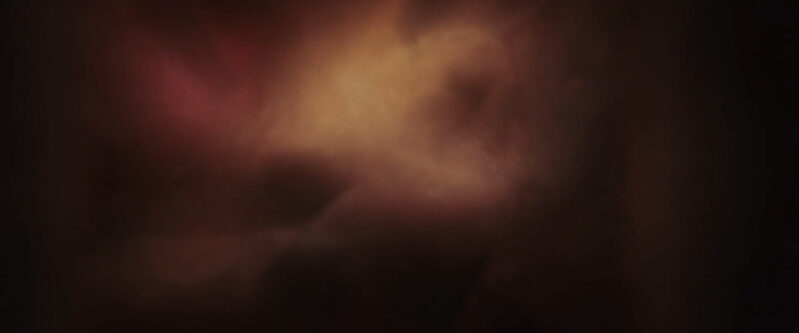
The title of Mother! is significant in several ways, as it encapsulates the film’s various themes and allegorical layers. Let’s explore the different dimensions of the title and its implications for understanding the movie’s complex narrative and symbolism.
Mother as the Protagonist
At the most literal level, the title Mother! refers to the film’s protagonist. Throughout the movie, she is simply referred to as “Mother,” a name that is both an identifier and a role she embodies. As the central character, her experiences and perspectives are the driving force of the narrative. The title, therefore, highlights her importance in the story and emphasizes her role as the primary lens through which the audience experiences the film’s events.
Mother as a Symbol of Mother Earth
The title also alludes to the allegorical nature of the film, with Mother serving as a representation of Mother Earth, or Gaia. In this interpretation, the character embodies the nurturing, life-giving aspects of the planet, as well as its vulnerability to human exploitation and destruction. Throughout the movie, Mother’s attempts to maintain and protect her home—an extension of herself—mirror the struggles of the Earth to preserve its balance and harmony in the face of human intervention. In this context, the title serves as a reminder of the film’s environmental message, urging viewers to consider the consequences of their actions on the planet.
Mother as a Reflection of Traditional Gender Roles
The title also reflects the exploration of traditional gender roles and expectations within the film. As the character of Mother navigates her relationship with Him, her husband and an embodiment of the divine creator, she often adheres to stereotypical expectations of femininity. She is expected to be nurturing, supportive, and self-sacrificing, prioritizing the needs of her husband and their home over her own desires and well-being. The title Mother! emphasizes this aspect of her character, reminding viewers of the societal pressures and expectations placed upon women, particularly in the context of marriage and family life.
Mother as the Universal Archetype
The title also evokes the universal archetype of the mother figure, a symbol that transcends cultural boundaries and resonates with audiences on a deep, psychological level. The character of Mother embodies the nurturing, protective, and life-giving aspects associated with this archetype, as well as the darker elements of sacrifice and suffering. By invoking this powerful symbol, the title encourages viewers to consider the broader implications of the mother archetype within the context of the film’s themes, such as creation and destruction, love and loss, and the cyclical nature of life.
The Exclamation Mark
Finally, the exclamation mark in the title Mother! is noteworthy, as it conveys a sense of urgency and intensity that reflects the film’s chaotic and emotionally charged atmosphere. The exclamation mark adds an element of surprise and shock to the title, hinting at the unsettling and provocative nature of the movie. It invites viewers to approach the film with curiosity and anticipation, signaling that the story will challenge their perceptions and provoke a strong emotional response.
Important motifs in Mother!
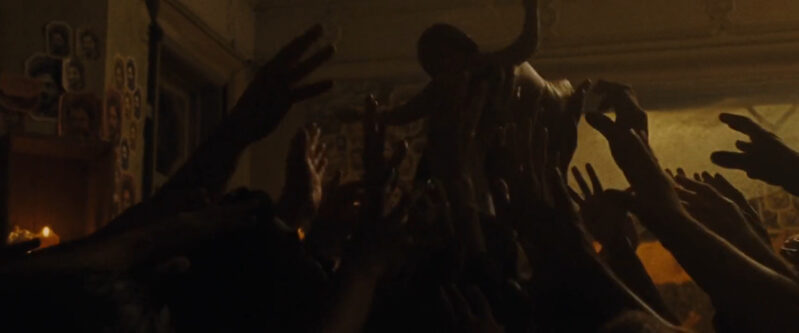
Creation and Destruction
This motif is central to Mother! and is embodied in the cyclical nature of the film. The movie begins with a burned house being restored and ends with the house being destroyed and the cycle starting anew. This cycle represents the balance of creation and destruction in the universe, as well as humanity’s role in this balance. The birth and death of the baby in the film further emphasize this motif, as does the shattering and reformation of the crystal.
Invasion of Privacy
Throughout the film, Mother’s personal space and sanctuary are repeatedly invaded by uninvited guests. This motif serves as a metaphor for the way humanity encroaches on and exploits the Earth’s resources without regard for the consequences. For example, when Man and Woman break the crystal in the forbidden room, their actions mirror the biblical story of Adam and Eve, where the first humans transgressed God’s command and brought suffering upon themselves and the world.
Motherhood
The theme of motherhood is embodied by Jennifer Lawrence’s character, who represents both a literal mother figure and the personification of Mother Earth. Her desire to protect her home and the life within it reflects the nurturing aspect of motherhood. The film explores the emotional turmoil that comes with being a mother, such as when Mother’s baby is taken from her and subsequently killed by the frenzied crowd, illustrating the vulnerability of creation and the deep pain associated with loss.
The Artist’s Ego
Javier Bardem’s character, Him, symbolizes the artist and his creative process. Throughout the film, his obsession with adoration and validation from others leads to the eventual destruction of his world. This motif highlights the consequences of unchecked ego and the dark side of creativity. The sacrifice of the baby, which is consumed by the crowd seeking a piece of the artist’s creation, is a powerful example of the destructiveness of the artist’s ego.
Biblical Allusions
Mother! is rife with biblical references, and these allusions serve as a foundation for the film’s allegorical narrative. Characters such as Man and Woman (Adam and Eve), their sons (Cain and Abel), and the setting of the house (the Garden of Eden) tie the story to biblical themes of creation, fall, and redemption. The flood-like scene during the chaotic party and the final apocalyptic destruction of the house further connect the film to biblical narratives and underscore the notion of humanity’s repeated transgressions and their consequences.
Questions & answers about Mother!
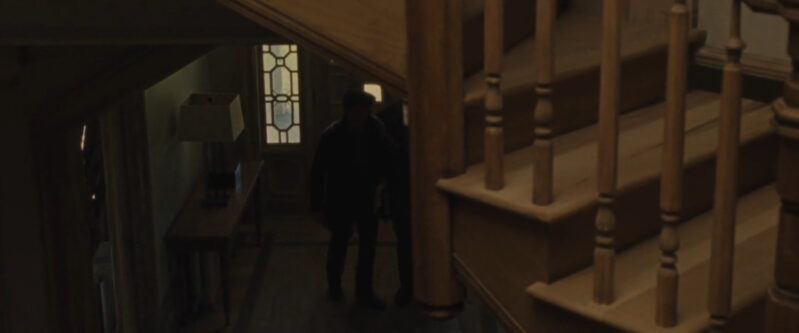
Who are the characters in Mother! supposed to represent?
In Mother!, the characters represent various allegorical figures. Mother symbolizes Mother Earth or Gaia, while Him represents God or the divine creator. The characters of Man and Woman are allusions to Adam and Eve from the Bible. Aronofsky confirmed these character interpretations in a Reddit AMA.
Why did the baby die in Mother!?
The death of the baby in Mother! symbolizes the vulnerability of the artist’s creation when exposed to the public. In the film, the frenzied crowd consumes the baby, highlighting the destructive nature of fame and the vulnerability of creative works in the public domain. The scene can also be seen as a commentary on the way humanity treats the Earth and its resources.
Why is the film called Mother! with an exclamation mark?
The exclamation mark in the title Mother! conveys a sense of urgency and intensity, reflecting the film’s chaotic and emotionally charged atmosphere. It adds an element of surprise and shock to the title, hinting at the unsettling and provocative nature of the movie. The title itself highlights the importance of the protagonist, Mother, and her role as both the film’s central character and a symbolic representation of Mother Earth.
What does the house represent?
The house in Mother! represents the Earth itself, with Mother, serving as an embodiment of Mother Earth or Gaia. Throughout the film, Mother’s efforts to maintain and protect her home mirror the struggles of the Earth to preserve its balance and harmony in the face of human intervention. The house’s destruction towards the end of the film symbolizes the devastation that humanity can inflict upon the Earth.
What does the crystal symbolize?
The crystal in Mother! is a representation of the divine creative spark or inspiration, and it is also symbolic of life and the cycle of creation, destruction, and rebirth. In the film, Him cherishes the crystal and uses it to bring life to the house (Earth) and create his poems. The crystal is shattered when Man and Woman, allegorical figures for Adam and Eve, enter the forbidden room, which parallels the biblical story of the fall of man. At the end of the film, after the house is destroyed, Him extracts a new crystal from the ashes of Mother, indicating the beginning of a new cycle of creation. Aronofsky had discussed the cyclical nature of the crystal in a Collider interview (that’s since been removed from their site).
What is the yellow powder?
The yellow powder in Mother! is never explicitly explained, but it can be interpreted as a metaphor for Mother’s dependence on external support or as a representation of human reliance on substances for coping or healing. In the film, Mother dissolves the yellow powder in water and drinks it to alleviate her anxiety and distress caused by the events occurring in the house. This act can also be seen as a commentary on the use of medication or substances to numb emotional pain. Since Mother represents Mother Earth, we can think of this liquid as an ethereal substance that serves a purpose beyond our understanding.
What is the heart inside the walls?
The pulsating heart inside the walls of the house symbolizes the living essence of the Earth, with the house representing the planet itself. As a representation of Mother Earth, Mother character is intrinsically connected to the house, and the heart serves as a visual manifestation of this bond. The gradual decay of the heart throughout the film mirrors the deterioration of the house and reflects the mounting chaos and destruction caused by human interference.
What do the intruders represent?
The intruders in Mother! represent humanity and its various facets, such as selfishness, greed, and destructive tendencies. As the film progresses, more and more uninvited guests arrive at the house, causing chaos, damaging the home, and disregarding Mother’s pleas for respect and order. These intruders can be seen as an allegory for the way humans exploit the Earth and its resources, often with little regard for the consequences of their actions.
What does the bloody hole in the ground represent?
The bloody hole in the ground symbolizes the violence and destruction that humanity is capable of inflicting upon the Earth. It appears after one of the intruders (Cain) kills his brother (Abel) in an act of rage, an event that mirrors the biblical story of Cain and Abel, the first murder in human history. The hole serves as a reminder of the dark side of human nature and the potential for violence and devastation that humans can bring to the world.
Now it’s your turn
Have more unanswered questions about Mother!? Are there themes or motifs we missed? Is there more to explain about the ending? Please post your questions and thoughts in the comments section! We’ll do our best to address every one of them. If we like what you have to say, you could become part of our movie guide!

